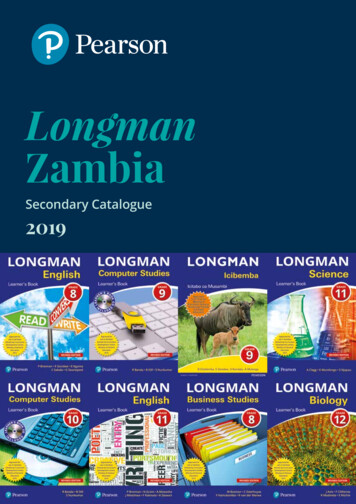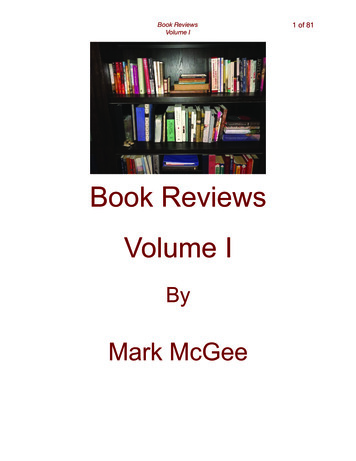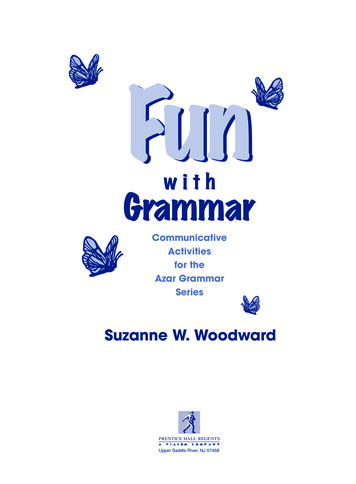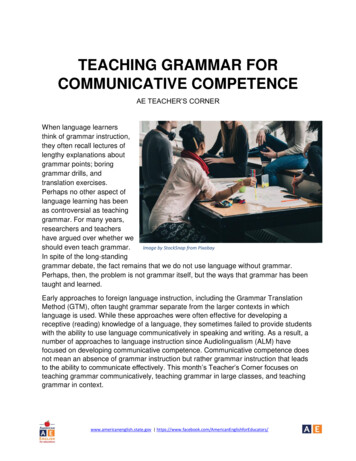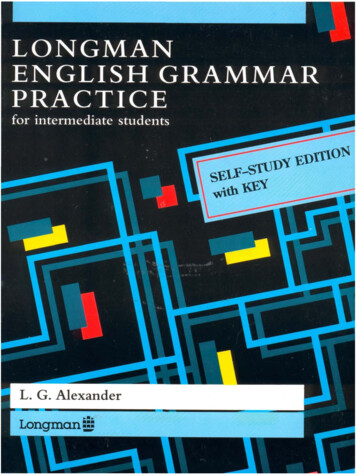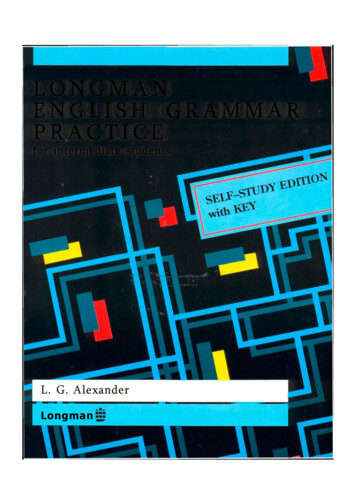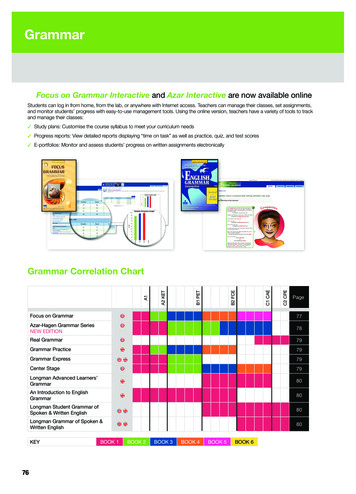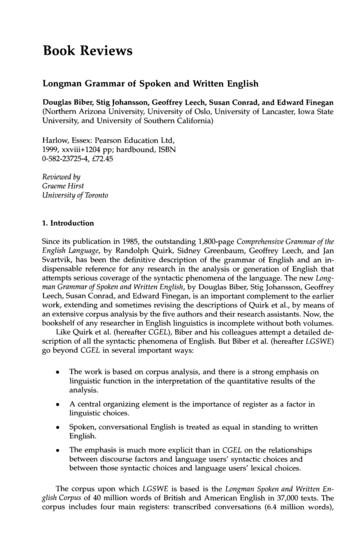
Transcription
Book ReviewsLongman Grammar of Spoken and Written EnglishDouglas Biber, Stig Johansson, Geoffrey Leech, Susan Conrad, and Edward Finegan(Northern Arizona University, University of Oslo, University of Lancaster, Iowa StateUniversity, and University of Southern California)Harlow, Essex: Pearson Education Ltd,1999, xxviii 1204 pp; hardbound, ISBN0-582-23725-4, 72.45Reviewed byGraeme HirstUniversity of Toronto1. IntroductionSince its publication in 1985, the outstanding 1,800-page ComprehensiveGrammar of theEnglish Language, by Randolph Quirk, Sidney Greenbaum, Geoffrey Leech, and JanSvartvik, has been the definitive description of the grammar of English and an indispensable reference for any research in the analysis or generation of English thatattempts serious coverage of the syntactic phenomena of the language. The new Longman Grammar of Spoken and Written English, by Douglas Biber, Stig Johansson, GeoffreyLeech, Susan Conrad, and Edward Finegan, is an important complement to the earlierwork, extending and sometimes revising the descriptions of Quirk et aL, by means ofan extensive corpus analysis by the five authors and their research assistants. Now, thebookshelf of any researcher in English linguistics is incomplete without both volumes.Like Quirk et al. (hereafter CGEL), Biber and his colleagues attempt a detailed description of all the syntactic phenomena of English. But Biber et al. (hereafter LGSWE)go beyond CGEL in several important ways: The work is based on corpus analysis, and there is a strong emphasis onlinguistic function in the interpretation of the quantitative results of theanalysis. A central organizing element is the importance of register as a factor inlinguistic choices. Spoken, conversational English is treated as equal in standing to writtenEnglish. The emphasis is much more explicit than in CGEL on the relationshipsbetween discourse factors and language users' syntactic choices andbetween those syntactic choices and language users' lexical choices.The corpus upon which LGSWE is based is the Longman Spoken and Written English Corpus of 40 million words of British and American English in 37,000 texts. Thecorpus includes four main registers: transcribed conversations (6.4 million words),
Book Reviewsfiction (5.0 million words), news (10.7 million words), and academic prose (5.3 million words); in addition, there are two supplementary registers: 5.7 million words ofnonconversational speech and 6.9 million words of general prose.The transcribed conversations are of particular note. British and American informants surreptitiously tape-recorded all their conversations for a week. (Other participants in the conversations were asked post hoc for consent to the use of the conversation in the corpus.) Throughout the book, the differences between conversationand the written registers are treated in detail, and Chapter 14 is devoted to particularaspects of conversation, such as how the constraints of real-time, interactive languageproduction influence the language user's choice of syntactic constructions.While the more mechanical parts of the corpus analysis were largely automatic(beginning with part-of-speech tagging), the main analyses were carried out manuallyby the authors with the aid of software for searching and manipulating the contents ofthe corpus. But manual analysis was also required for many of the relatively low-leveltasks, where semantic judgment was required to determine the function of a linguisticelement. For example, it still requires a human to reliably distinguish instances of thehedging use of sort of from instances of the regular noun-phrase use (you can sort ofwedge it in; what sort of ideas have you come up with? (p. 36)) and to tease out the semanticsof the genitive in a coordinate construction (we present Berg and Muscat's definition refersto just one definition; but Andrew and Horatia's eyes met refers to two separate pairs ofeyes (p. 298)).Table 1 lists the titles of the chapters, along with my gloss of the contents of each.A complete listing of even the first-level subheadings would take much more space.2. The AnalysisA typical section of LGSWE takes a syntactic phenomenon of English, describing it ingeneral terms. It is then subcategorized, each subcategory is explained, and a crossregister corpus analysis of the phenomenon is presented, highlighting its distributionin each register and the distribution of the subcategories. If the subcategories aresemantic, a corpus analysis is presented of the various possible syntactic realizations ofeach. Tables, sometimes quite long, are often given of relevant words and the frequencyof some specific behavior. The results are then discussed qualitatively, emphasizing thefunctional aspects of syntactic choice. Constructions are analyzed with respect to thework or tasks that they perform, their relation to cognitive constraints on languageproduction, and their social indexing (pp. 41-44). The tasks of linguistic features aredivided into the ideational, textual (serving to mark information structure or textualcohesion), personal, interpersonal, contextual, and aesthetic. The following quotationsexemplify the style of the analysis:That-clauses functioning as noun complements are one of the primarydevices used to mark stance in academic prose. (p. 648)There is a clear stylistic difference between interrogative /f-clauses,which are strongly favored in the more colloquial style of conversation and fiction, and interrogative whether-clauses, which are moreneutral in their stylistic range. (p. 691)In [academic prose,] fronting serves to juxtapose items which throughsemantic repetition cohesively tie the sentences together. Conversation and fiction, by contrast, strive for greater impact and stylistic133
Computational LinguisticsVolume 27, Number 1Table 1Synopsis of the contents of Longman Grammar of Spoken and Written English.A. Introductory1. A corpus-based approach to English grammarIntroduction to the basic concepts of the work, including the use of the corpus.K Basic grammar2. Word and phrase grammarThe characteristics of words; the basic word classes; function words; thecharacteristics of phrases; types of phrase; embedding and coordination of phrases.3. Clause grammarThe major elements of clauses and their patterns; peripheral elements; ellipsis;negation; subject-verb concord; dependent and independent clauses.C. Key word classes and their phrases4. Nouns, pronouns, and the simple noun phraseTypes of nouns; determiners; number; case; gender; derived nouns; pronouns.5. VerbsSingle-word and multiword verbs; semantic domains; valency; auxiliaries; copulas.6. Variation in the verb phraseTense; aspect; voice; modality.7. Adjectives and adverbialsTypes of adjectives; comparatives and superlatives; formation of adjectives; syntacticroles of adverbs; semantic categories of adverbs.D. More complex structures8. Complex noun phrasesPremodification; nominal sequences; restrictive and nonrestrictive postmodifiers;postmodification by relative clauses, prepositional phrases, and appositives.9. The form and function of complement clausesthat, wh-, -ing, and infinitive clauses.10. AdverbialsCircumstance, stance, and linking adverbials.E. Grammar in a wider perspective11. Word order and related syntactic choicesMarked word orders, such as inversions; passive constructions; existential there; clefts.12. The grammatical marking of stanceKinds of stance; attribution of stance.13. Lexical expressions in speech and writingCollocations ("lexical bundles"); idioms; free verb-particle combinations;binomial phrases.14. The grammar of conversationDifferences between conversation and writing; dysfluencies; grammaticalcharacteristics of sentences constructed in real time.End matterAppendix: ContractionEnd notesBibliographyLexical and conceptual indexes134
Book Reviewseffect, so we find types of fronting which chiefly convey special emphasis and contrast especially fronting of objects but also some fronting of predicatives. (p. 910).At the lexical level, there is a strong emphasis on collocation, which the authorsgeneralize to the notion of lexical bundles, "sequences of word forms that commonlygo together in natural discourse" (p. 990)--for example, are shown in table, should benoted that, you want a cup of tea, thank you very much, got nothing to do with. Chapter 13includes long tables of four- to six-word lexical bundles common in conversation andacademic prose, classified by structure.The authors adopt a prototype view of word classes in the style of Lakoff (1987,Chap. 3) (though it is not described in those terms), with classes having core andperipheral members: "nouns can be more or less 'nouny'" (p. 59). Nonetheless, theauthors categorize words as much as they possibly can, introducing novel classes suchas semi-determiners: "determiner-like words which are often described as adjectives. [but] have no descriptive meaning" (p. 280)--for example, same, other,former, latter.This varies from CGEL's analysis, in which the adjectival aspect of such words isemphasized (e.g., pp. 430-431).Despite the emphasis on frequency data, there are few actual numbers. In the textitself, most of the results are given qualitatively, with just occasional, isolated numericdata points that are usually approximations. For example, the past perfect is comparedwith the simple past tense in these three bullet points (p. 469): The past perfect aspect has accompanying time adverbials a greaterpercentage of the time than does the simple past tense. Past perfect verb phrases often occur in dependent clauses. Taken together, these two factors (time adverbials and dependentclauses) account for c. 70% of all occurrences of past perfect verb phrases.(Statistical significance is never noted; the authors promise in the introduction (p. 40)that anything reported is statistically significant.) Even the tables and figures are rarelynumeric. Most quantitative data are reported as histograms, but the histograms, eitherby their small size or by their design (see below), are very low in precision and areapparently intended only for quick visual impressions.A representative section is 10.2 (pp. 776ff.), on circumstance adverbials. The firstsubsection describes the different semantic categories of these adverbials (place, time,means, etc). The second subsection gives corpus results on the frequencies of eachof the categories in each of the four registers of the corpus, with discussion of thefunctional significance of the findings; for example, "News is particularly concernedwith current events. Time adverbials are therefore commonly used to make clear whenevents happened or to give background leading up to the current event" (p. 785). Thenext three subsections give the frequencies of different kinds of phrasal and lexicalrealizations of each of the semantic categories, including a 2.5-page table of the frequencies in each of the registers of the most common lexical realizations. Differencesbetween British and American usage are highlighted; for example, a large differenceis found in the choice between relative and absolute references to time in the newsregister: yesterday is eight times more common, and this morning is more than twiceas common, in the British news subcorpus than in the American news subcorpus,whereas names of days of the week are 28 times more frequent in the latter. The nexttwo subsections look at the frequencies with which the circumstance adverbials occur135
Computational LinguisticsVolume 27, Number 1in different positions within the sentence and the correlation between their position,semantic category, and length, and then at the order of occurrence of multiple circumstance adverbials within the same sentence. The final subsection, which is almost aslong as all the others together, repeats much of this analysis for clausal realizations ofcircumstance, which the authors find to be different enough from phrasal and lexicalrealization to warrant a separate presentation of the analysis. In total, this section is77 pages long.The authors are generous with the use of examples from the corpus to illustratetheir descriptions. Often, the selection of examples is as large as, or even larger than,the description itself; for example, Section 10.2.1.2, on circumstance adverbials of time,consists of five sentences by the authors and 14 example sentences from the corpus.And as anyone who has worked with corpora knows, it is sometimes hard to avoid thedistraction of reading the data for its own sake; similarly, in LGSWE, it's easy to startskipping over the authors' text in order to hurry to the next example. One suspectsthe authors of having sometimes deliberately chosen the most enticing examples fromthe corpus to illustrate each point; I got particularly hung up trying to construct astory around one example on page 809:One day I left the Yale on the latch accidentally, and when I came backI found a brand-new shelf, with a brass rod below it, high up in theshallow recess beside the fire.Other examples highlight the drama of daily life (pp. 1104, 746, 1119):A: Can I have a drink?B: Yeah, what would you like?A: I would like strawberry.B: With or without ice?A: With.She keeps smelling the washing powder.Yeah, he went "Oh!" He goes, "Who put that there?" And the bitwhere he goes he goes "Urgh, cobwebs", and she goes "Piss off!" Shegoes "Mum, come and sit here", she goes "Piss off!" like that and themother goes "You talking to me?"3. Empiricism versus prescriptivismSince many lay readers of LGSWE will turn to the book for guidance in "correctEnglish," the authors are careful to emphasize that their work is descriptive, not prescriptive. Of course, this is not to say that the book is not of use as a guide for thosewho are uncertain in their usage; any writer who wants to ensure that his or herusage is in accord with English norms, be they prescriptive or statistical, will findit extremely helpful. For example, the section on verb concord with existential there(p. 186) spends some time discussing the fact that the prescriptively deprecated useof a singular verb followed by a plural noun phrase (There's apples if you want one) isactually more common in conversation than the prescriptively approved form (Thereare apples. ). But there is less emphasis than in CGEL on the identification of prescriptively deprecated or stigmatized forms. Indeed, whenever prescriptivism is mentionedin LGSWE, a certain tension arises. For example, the section on dangling participles136
Book Reviews(p. 829) first mentions the prescriptivist proscription of such participles as if preparingto discard it, but then concedes that violation of the rule can lead to absurd interpretations; and the examples offered are constructed rather than selected from the corpus,implying that none were found in the corpus and hence that dangling participles haveno part in even a purely descriptive grammar. (The section closes with some corpusexamples of unattached participles that don't "dangle" in the proscribed manner.) Inanother round of prescriptivism-bashing on pages 83-84, we read:There is a well-known prescriptive reaction against beginning anorthographic sentence with a coordinator [such as but]. Nevertheless, in actual texts, we quite frequently find coordinators in this position . . . . The prescription against initial coordinators seems most influential in academic prose. The higher frequencies in fiction and newsreportage probably reflect the fact that these registers often includemore spontaneous discourse, including fiction dialogue and quotedspeech in news, evidencing the lack of attention to prescriptive rulesof ordinary speech.But while plausible, this is just speculation, and is not in keeping with the authors'own stated goal of explaining their corpus observations in terms of linguistic function;it simply cannot be determined from the corpus data whether or not prescriptivisminfluences the observed tendency of academic writers to avoid sentence-initial coordinators. (It certainly didn't influence my writing of the previous sentence. 1)4. PragmaticsLGSWE far exceeds CGEL in the quality of its index, which was prepared by MegDavies. The authors have learned from the problems of CGEL's enormous index (byDavid Crystal), which, while very comprehensive, frustrates the user by being verysparing with its subheadings. It is not unusual for a single CGEL index entry orsubentry to list more than 50 locators without differentiation; moreover, the locatorsare paragraph numbers, not page numbers, although the design of the book makesit hard to find the paragraph numbers when flipping pages. By contrast, the indexof LGSWE uses descriptive subheadings for every small group of locatorsmand thelocators are page numbers. In addition, the lexical index is separate from the conceptualindex, which also adds to ease of use.LGSWE is an attractive, well-designed, and well-typeset book. I noticed no significant typos or errors of copyediting. But I must admit to being both mystified andsomewhat annoyed by the histograms. Five different styles are used, all of them lowin resolution: cumulative vertical bars, adjacent vertical bars, horizontal bars of a fewdiscrete lengths, horizontal rows of squares, and horizontal rows of circles. The vertical styles require the reader to distinguish up to six shades of grey. The horizontalstyles have no scale, but rather a legend such as "each mrepresents 5%," so that onehas to count the squares or circles. Confusingly, the style chosen for any particularhistogram seems often to be random and unrelated to either the nature of the datashown or the logic of the display. For example, Tables 5.26-28 (pp. 432-3) show thedistribution across registers of various forms of do; the first two tables use horizontal1 When I was young, my grandmotheradmonishedme that the word but must alwaysbe preceded by asemicolon;but it was clear that she herselfdid not agree with this rule, and was passing it on to a newgeneration merelyas her grandmotherlyduty.137
Computational LinguisticsVolume 27, Number 1squares, but the third uses horizontal circles. And then Table 5.31 (p. 437) shows similardata--frequencies of common copular verbs across registers--by means of terms suchas "rare" and "relatively common": a verbal histogram! A similarly disparate groupappears on page 784: Figure 10.4 shows the raw frequencies of semantic categoriesof circumstance adverbials across the registers as cumulative vertical bars, whereasFigure 10.5, immediately adjacent, shows the percentage data for one subcategory ofthese adverbials as adjacent vertical bars, and Table 10.3, just below, shows similardata for a different subcategory as horizontal rows of squares. (Moreover, Table 10.3is captioned in quite different terms from Figure 10.5, although the two are in factlogically parallel.) I spent a while puzzling over what the difference was supposedto be in meaning, implication, or function between all these styles, but finally had toconclude that there was none.The book seems to be well bound, and comes in a slipcase to help protect it.Again, this contrasts with CGEL, whose binding was inadequate for heavy use of aheavy book; my copy fell part after five or six years of repeated use and loans tostudents with backpacks, and had to be re-bound.The publicity brochure that came with the review copy of LGSWE gave its price as 69.00, but as this review is written, the price given on the Longman Web site is 72.45;Amazon lists it for 119 (and CGEL for 247). This is not expensive for an academicbook, especially one of this size and one in which the publisher has invested so muchin resources, but it is sufficient to keep it out of reach of many students and otherswho would benefit from owning their own copy. By contrast, the hardback edition ofthe 1670-page Longman Dictionary of Contemporary English (third edition with CD-ROM)is only 20.88 ( 39 at Amazon).5. ConclusionDespite its size and all the work that went into it, LGSWE is not a replacement forCGEL but rather a complement to it; indeed, the authors explicitly describe it as such(p. viii). In particular, the descriptions of English grammar in CGEL are perhaps twiceas extensive as those of LGSWE. (CGEL is about 1.5 times larger than LGSWE, and yethas far fewer examples and no corpus analyses.) This is not to say that LGSWE doesn'tstand on its own. It does, and for many people, it is the only book of English grammarthat they need. In fact, many students will get by just fine with one of the many lessdetailed and more-concise books available, such as those of Wardhaugh (1995), Baker(1995), Greenbaum (1996), or McCawley (1998) or the student abridgement of CGEL(Greenbaum and Quirk 1990). But the most serious users, including many readers ofthis journal, will now wish to consult both LGSWE and CGEL on any question of themore subtle aspects of English grammar and lexis.AcknowledgmentsI am grateful to Suzanne Stevenson andNadia Talent for helpful comments on earlierdrafts of this review. Preparation of thereview was supported by a grant from theNatural Sciences and Engineering ResearchCouncil of Canada.ReferencesBaker, C.L. 1995. English Syntax (secondedition). The MIT Press, Cambridge, MA.138Greenbaum, Sidney. 1996. The Oxford EnglishGrammar. Oxford University Press.Greenbaum, Sidney and Randolph Quirk.1990. A Student's Grammar of the EnglishLanguage. Longman.Lakoff, George. 1987. Women, Fire,andDangerous Things: What Categories Revealabout the Mind. The University of ChicagoPress.McCawley, James. 1998. The SyntacticPhenomena of English (second edition). TheUniversity of Chicago Press.
Book ReviewsQuirk, Randolph, Sidney Greenbaum,Geoffrey Leech, Jan Svartvik. 1985. AComprehensive Grammar of the EnglishLanguage. Longman.Wardhaugh, Ronald. 1995. UnderstandingEnglish Grammar: A linguistic approach.Blackwell, Oxford.Graeme Hirst is the book review editor of Computational Linguistics. His research topics includelexical and syntactic indicators of style, the problem of near-synonymy in machine translation,and computational models of linguistic context. Hirst's address is Department of ComputerScience, University of Toronto, Toronto, Ontario, Canada M5S 3G4; e-mail: gh@cs.toronto.edu;URL: http://www.cs.toronto.edu/ gh.139
Book Reviews Longman Grammar of Spoken and Written English Douglas Biber, Stig Johansson, Geoffrey Leech, Susan Conrad, and Edward Finegan (Northern Arizona University, University of Oslo, University of Lancaster, Iowa State University, and University of S


